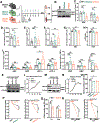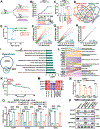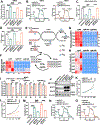METTL16 drives leukemogenesis and leukemia stem cell self-renewal by reprogramming BCAA metabolism
- PMID: 36608679
- PMCID: PMC9838187
- DOI: 10.1016/j.stem.2022.12.006
METTL16 drives leukemogenesis and leukemia stem cell self-renewal by reprogramming BCAA metabolism
Abstract
N6-methyladenosine (m6A), the most prevalent internal modification in mammalian mRNAs, is involved in many pathological processes. METTL16 is a recently identified m6A methyltransferase. However, its role in leukemia has yet to be investigated. Here, we show that METTL16 is a highly essential gene for the survival of acute myeloid leukemia (AML) cells via CRISPR-Cas9 screening and experimental validation. METTL16 is aberrantly overexpressed in human AML cells, especially in leukemia stem cells (LSCs) and leukemia-initiating cells (LICs). Genetic depletion of METTL16 dramatically suppresses AML initiation/development and maintenance and significantly attenuates LSC/LIC self-renewal, while moderately influencing normal hematopoiesis in mice. Mechanistically, METTL16 exerts its oncogenic role by promoting expression of branched-chain amino acid (BCAA) transaminase 1 (BCAT1) and BCAT2 in an m6A-dependent manner and reprogramming BCAA metabolism in AML. Collectively, our results characterize the METTL16/m6A/BCAT1-2/BCAA axis in leukemogenesis and highlight the essential role of METTL16-mediated m6A epitranscriptome and BCAA metabolism reprograming in leukemogenesis and LSC/LIC maintenance.
Keywords: AML; BCAA metabolism; BCAT1; BCAT2; LSCs/LICs; METTL16; leukemia stem cells; leukemia-initiating cells; m6A modification; self-renewal.
Copyright © 2022 Elsevier Inc. All rights reserved.
Conflict of interest statement
Declaration of interests J.C. is a scientific advisory board member of Race Oncology.
Figures







Comment in
-
New readers and writers of RNA modifications unique to leukemia stem cells.Cell Stem Cell. 2023 Jan 5;30(1):3-4. doi: 10.1016/j.stem.2022.12.011. Cell Stem Cell. 2023. PMID: 36608677
References
-
- Stubbs MC, and Armstrong SA (2007). Therapeutic implications of leukemia stem cell development. Clin Cancer Res 13, 3439–3442. - PubMed
Publication types
MeSH terms
Substances
Grants and funding
LinkOut - more resources
Full Text Sources
Medical
Molecular Biology Databases
Research Materials

